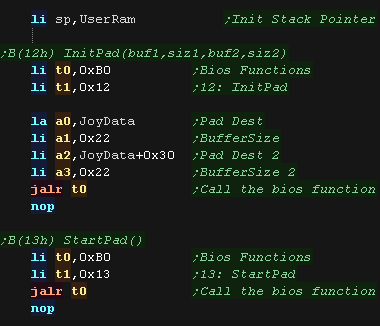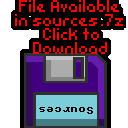

MIPS Assembly programming for the Playstation 1 (PS1/PSX)
|
 |
Documentation
Nocash PSXSPX Playstation SpecificationsMemory Map
| KUSEG | KSEG0 (Cached) |
KSEG1 (Uncached) |
KSEG2 (IO Ports) |
Size | Purpose |
| 0x00000000 | 0x80000000 | 0xA0000000 | -- | 2048K |
Main RAM (first 64K reserved for BIOS) |
| 0x1F000000 | 0x9F000000 | 0xBF000000 | -- | 8192K | Expansion Region 1 (ROM/RAM) |
| 0x1F800000 | 0x9F800000 | -- | -- | 1K | Scratchpad (D-Cache used as Fast RAM) |
| 0x1F801000 | 0x9F801000 | 0xBF801000 | -- | 8K | I/O Ports |
| 0x1F802000 | 0x9F802000 | 0xBF802000 | -- | 8K | Expansion Region 2 (I/O Ports) |
| 0x1FA00000 | 0x9FA00000 | 0xBFA00000 | -- | 2048K | Expansion Region 3 (whatever purpose) |
| 0x1FC00000 |
0x9FC00000 |
0xBFC00000 |
-- | 512K | BIOS ROM (Kernel) (4096K max) |
| -- | -- | -- | 0xFFFE0000 |
0.5K | I/O Ports (Cache Control) |
Gpu Commands
Written to port 0x1F801810
| Function | Byte | 31 | 30 | 29 | 28 | 27 | 26 | 25 | 24 | 23 | 22 | 21 | 20 | 19 | 18 | 17 | 16 | 15 | 14 | 13 | 12 | 11 | 10 | 9 | 8 | 7 | 6 | 5 | 4 | 3 | 2 | 1 | 0 |
| Clear Cache | 0 | 0x01 | 0 | ||||||||||||||||||||||||||||||
| Function | Byte | 31 | 30 | 29 | 28 | 27 | 26 | 25 | 24 | 23 | 22 | 21 | 20 | 19 | 18 | 17 | 16 | 15 | 14 | 13 | 12 | 11 | 10 | 9 | 8 | 7 | 6 | 5 | 4 | 3 | 2 | 1 | 0 |
| Set Screen Width | 0 | 0x06 | End X | Start X | |||||||||||||||||||||||||||||
| Function | Byte | 31 | 30 | 29 | 28 | 27 | 26 | 25 | 24 | 23 | 22 | 21 | 20 | 19 | 18 | 17 | 16 | 15 | 14 | 13 | 12 | 11 | 10 | 9 | 8 | 7 | 6 | 5 | 4 | 3 | 2 | 1 | 0 |
| Send image to Framebuffer | 0 | 0xA0 | |||||||||||||||||||||||||||||||
| CPU to VRAM | 1 | Y | X | ||||||||||||||||||||||||||||||
| 2 | H | W | |||||||||||||||||||||||||||||||
| 3 | Pixel 2 | Pixel 1 | |||||||||||||||||||||||||||||||
| .. | .. | ... | |||||||||||||||||||||||||||||||
| n | Pixel n*2+1 | Pixel n*2 | |||||||||||||||||||||||||||||||
| Function | Byte | 31 | 30 | 29 | 28 | 27 | 26 | 25 | 24 | 23 | 22 | 21 | 20 | 19 | 18 | 17 | 16 | 15 | 14 | 13 | 12 | 11 | 10 | 9 | 8 | 7 | 6 | 5 | 4 | 3 | 2 | 1 | 0 |
| Fill Area | 0 | 0x02 | Color | ||||||||||||||||||||||||||||||
| 1 | Y | X | |||||||||||||||||||||||||||||||
| 2 | H | W | |||||||||||||||||||||||||||||||
| Function | Byte | 31 | 30 | 29 | 28 | 27 | 26 | 25 | 24 | 23 | 22 | 21 | 20 | 19 | 18 | 17 | 16 | 15 | 14 | 13 | 12 | 11 | 10 | 9 | 8 | 7 | 6 | 5 | 4 | 3 | 2 | 1 | 0 |
| Copy Rectangle | 0 | 0x80 | |||||||||||||||||||||||||||||||
| VRAM to VRAM | 1 | SY | SX | ||||||||||||||||||||||||||||||
| 2 | DY | DX | |||||||||||||||||||||||||||||||
| 3 | H | W | |||||||||||||||||||||||||||||||
| Function | Byte | 31 | 30 | 29 | 28 | 27 | 26 | 25 | 24 | 23 | 22 | 21 | 20 | 19 | 18 | 17 | 16 | 15 | 14 | 13 | 12 | 11 | 10 | 9 | 8 | 7 | 6 | 5 | 4 | 3 | 2 | 1 | 0 |
| Get image from Framebuffer | 0 | 0xC0 | |||||||||||||||||||||||||||||||
| VRAM to CPU | 1 | Y | X | ||||||||||||||||||||||||||||||
| 2 | H | W | |||||||||||||||||||||||||||||||
| read from GPUREAD port | 3 | Pixel 2 | Pixel 1 | ||||||||||||||||||||||||||||||
| .. | .. | ... | |||||||||||||||||||||||||||||||
| n | Pixel n*2+1 | Pixel n*2 | |||||||||||||||||||||||||||||||
Screen Memory
Each pixel is represented by one BIG ENDIAN word, in the format %-BBBBBGGGGGRRRRR
Joypad Bits
| We want to start the joypad reading routine. First we set up a valid stack pointer, Next we're going to call the bios function at address 0x000000B0 The command is stored in register T1, A1,A2,A3 and A4 contain the parameters We point A0 and A2 to 'Joydata'... once we perform these two bios calls, the JoyData memory will automatically be updated with the data from the joypad |
 |
The format of the bits in 'JoyData are shown below:
| Bits | ||||||||
| Byte |
7 |
6 |
5 |
4 |
3 |
2 |
1 |
0 |
| 0 | N/A | |||||||
| 1 | 0x41 �A� | |||||||
| 2 | 0x5A �Z� | |||||||
| 3 | LEFT | DOWN | RGHT | UP | START | 1 | 1 | SELECT |
| 4 | SQUARE | X | O | TRIANGL | R1 | L1 | R2 | L2 |
Endian
The N64 is BIG ENDIAN
the PSX is LITTLE ENDIAN
| View Options |
| Default Dark |
| Simple (Hide this menu) |
| Print Mode (white background) |
| Top Menu |
| ***Main Menu*** |
| Youtube channel |
| Patreon |
| Introduction to Assembly (Basics for absolute beginners) |
| Amazon Affiliate Link |
| AkuSprite Editor |
| ChibiTracker |
| Dec/Bin/Hex/Oct/Ascii Table |
| Alt Tech |
| Archive.org |
| Bitchute |
| Odysee |
| Rumble |
| DailyMotion |
| Please note: I wlll upload more content to these alt platforms based on the views they bring in |
| 68000 Content |
| ***68000 Tutorial List*** |
| Learn 68000 Assembly |
| Hello World Series |
| Platform Specific Series |
| Simple Samples |
| Grime 68000 |
| 68000 Downloads |
| 68000 Cheatsheet |
| Sources.7z |
| DevTools kit |
| 68000 Platforms |
| Amiga 500 |
| Atari ST |
| Neo Geo |
| Sega Genesis / Mega Drive |
| Sinclair QL |
| X68000 (Sharp x68k) |
| 8086 Content |
| Learn 8086 Assembly |
| Platform Specific Series |
| Hello World Series |
| Simple Samples |
| 8086 Downloads |
| 8086 Cheatsheet |
| Sources.7z |
| DevTools kit |
| 8086 Platforms |
| Wonderswan |
| MsDos |
| ARM Content |
| Learn ARM Assembly |
| Learn ARM Thumb Assembly |
| Platform Specific Series |
| Hello World |
| Simple Samples |
| ARM Downloads |
| ARM Cheatsheet |
| Sources.7z |
| DevTools kit |
| ARM Platforms |
| Gameboy Advance |
| Nintendo DS |
| Risc Os |
| Risc-V Content |
| Learn Risc-V Assembly |
| Risc-V Downloads |
| Risc-V Cheatsheet |
| Sources.7z |
| DevTools kit |
| MIPS Content |
| Learn Risc-V Assembly |
| Platform Specific Series |
| Hello World |
| Simple Samples |
| MIPS Downloads |
| MIPS Cheatsheet |
| Sources.7z |
| DevTools kit |
| MIPS Platforms |
| Playstation |
| N64 |
| PDP-11 Content |
| Learn PDP-11 Assembly |
| Platform Specific Series |
| Simple Samples |
| PDP-11 Downloads |
| PDP-11 Cheatsheet |
| Sources.7z |
| DevTools kit |
| PDP-11 Platforms |
| PDP-11 |
| UKNC |
| TMS9900 Content |
| Learn TMS9900 Assembly |
| Platform Specific Series |
| Hello World |
| TMS9900 Downloads |
| TMS9900 Cheatsheet |
| Sources.7z |
| DevTools kit |
| TMS9900 Platforms |
| Ti 99 |
| 6809 Content |
| Learn 6809 Assembly |
| Learn 6309 Assembly |
| Platform Specific Series |
| Hello World Series |
| Simple Samples |
| 6809 Downloads |
| 6809/6309 Cheatsheet |
| Sources.7z |
| DevTools kit |
| 6809 Platforms |
| Dragon 32/Tandy Coco |
| Fujitsu FM7 |
| TRS-80 Coco 3 |
| Vectrex |
| 65816 Content |
| Learn 65816 Assembly |
| Hello World |
| Simple Samples |
| 65816 Downloads |
| 65816 Cheatsheet |
| Sources.7z |
| DevTools kit |
| 65816 Platforms |
| SNES |
| eZ80 Content |
| Learn eZ80 Assembly |
| Platform Specific Series |
| eZ80 Downloads |
| eZ80 Cheatsheet |
| Sources.7z |
| DevTools kit |
| eZ80 Platforms |
| Ti84 PCE |
| IBM370 Content |
| Learn IBM370 Assembly |
| Simple Samples |
| IBM370 Downloads |
| IBM370 Cheatsheet |
| Sources.7z |
| DevTools kit |
| Super-H Content |
| Learn SH2 Assembly |
| Hello World Series |
| Simple Samples |
| SH2 Downloads |
| SH2 Cheatsheet |
| Sources.7z |
| DevTools kit |
| SH2 Platforms |
| 32x |
| Saturn |
| PowerPC Content |
| Learn PowerPC Assembly |
| Hello World Series |
| Simple Samples |
| PowerPC Downloads |
| PowerPC Cheatsheet |
| Sources.7z |
| DevTools kit |
| PowerPC Platforms |
| Gamecube |
| Work in Progress |
| ChibiAndroids |
| Misc bits |
| Ruby programming |
Buy my Assembly programming book
on Amazon in Print or Kindle!



Available worldwide!
Search 'ChibiAkumas' on
your local Amazon website!
Click here for more info!


Buy my Assembly programming book
on Amazon in Print or Kindle!



Available worldwide!
Search 'ChibiAkumas' on
your local Amazon website!
Click here for more info!


Buy my Assembly programming book
on Amazon in Print or Kindle!



Available worldwide!
Search 'ChibiAkumas' on
your local Amazon website!
Click here for more info!




